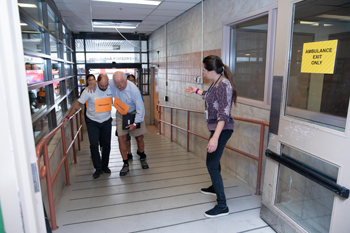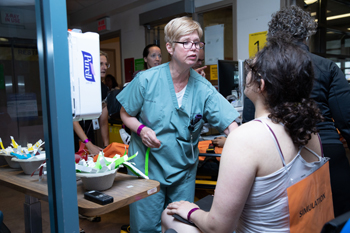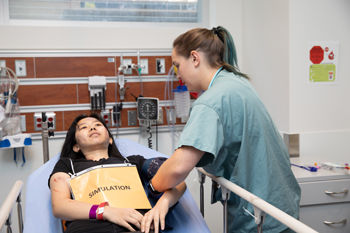Mock Code Orange: A lesson in emergency preparedness

By Jennifer Stranges

Volunteers and manikins helped bring a sense of reality to an exercise designed to put stress on the St. Michael’s ED to evaluate response protocols for when an actual Code Orange occurs. (Photos by Katie Cooper)
On the morning of Tuesday, Aug. 13, St. Michael’s Hospital’s Emergency Department (ED) registered an extraordinary 36 patients in 37 minutes. The patients ranged from those fighting for their lives, to the walking wounded, all in shock from the events which led them to one of the city’s busiest EDs.
Thankfully, the “patients” were not real or in real harm. They were volunteers, or in some cases manikins, who helped bring a sense of reality to an exercise designed to put stress on the St. Michael’s ED to evaluate response protocols for when an actual Code Orange – an external emergency – occurs.
Since late spring, registered nurse Candis Kokoski, emergency physicians Dr. Rachel Poley and Dr. Andrew Petrosoniak, and simulation educator Kristen Daly have been planning every detail of the exercise, which would take place while the ED was functioning as per usual. They developed the simulated scenario – an explosion at Toronto’s biggest transit hub, as well as comprehensive descriptions of injuries for each of the volunteers to act out.
“The fact that we ran this in a live ED is really exciting. There are a number of moving parts – we were registering real patients at the same time we were registering and treating sim patients,” said Dr. Petrosoniak, who is also a Clinical Integration and Translational Simulation Lead.
The challenge of conducting the exercise in a functioning Emergency Department was made easier by St. Michael’s simulation team. Simulation educator Kristen Daly notes that part of the simulation’s team’s role is to ensure all simulation activities follow best practices, including supporting the creation of contingency plans in case true medical needs arose. Patients already in the ED or arriving were made aware the event was happening and that they would be safe and cared for throughout the event.
The organizers are quick to mention that the success of the event was due in large part to the collaboration across the hospital including teams from IT, the blood bank, spiritual care and security, as well as the support of the hospital’s leadership. The magnitude of the exercise would not have been possible without teamwork, said Dr. Poley.
Use the dots to scroll through the gallery
“This is one of, if not the largest, in-situ simulation in a fully functioning Emergency Department that has occurred in Canada,” she said. “We had over 50 volunteers!”
The mock Code Orange also provided the hospital with an opportunity to test a new process for blood delivery.
“Getting blood products to patients in an efficient manner is so important in trauma care,” said Kokoski. A new method of managing blood for patients prior to their arrival was recently designed and was trialed during the simulation.
During the exercise, organizers monitored the emergency team’s response and documented all feedback to adjust processes and roles with the goal of improving upon their already well-functioning response.
Dr. Petrosoniak likens the exercise to a crash test for a car.
“Essentially, we crash-tested our Code Orange system to explore does it work, do people work the way we expect them to, is our equipment ready, are we?”
And ready they were.
In the 36 mock patients involved in the simulation, organizers had snuck in one volunteer who was part of the simulation and presenting with a heart attack unrelated to the explosion. They hoped that registration would detect the heart attack, and that amidst the chaos, provide the necessary treatment. Staff passed that test with flying colours, says Dr. Petrosoniak.
“It was unbelievable – a huge win.”
About St. Michael's Hospital
St. Michael’s Hospital provides compassionate care to all who enter its doors. The hospital also provides outstanding medical education to future health care professionals in more than 27 academic disciplines. Critical care and trauma, heart disease, neurosurgery, diabetes, cancer care, care of the homeless and global health are among the Hospital’s recognized areas of expertise. Through the Keenan Research Centre and the Li Ka Shing International Healthcare Education Centre, which make up the Li Ka Shing Knowledge Institute, research and education at St. Michael’s Hospital are recognized and make an impact around the world. Founded in 1892, the hospital is fully affiliated with the University of Toronto.
About Unity Health Toronto
Unity Health Toronto, comprised of Providence Healthcare, St. Joseph’s Health Centre and St. Michael’s Hospital, works to advance the health of everyone in our urban communities and beyond. Our health network serves patients, residents and clients across the full spectrum of care, spanning primary care, secondary community care, tertiary and quaternary care services to post-acute through rehabilitation, palliative care and long-term care, while investing in world-class research and education. For more information, visit www.unityhealth.to.



